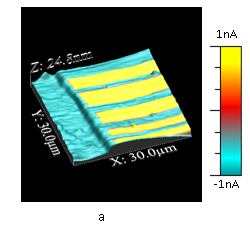"Characterization of the Photocurrents Generated by the Laser of Atomic Force Microscopes"
Review of Scientific Instruments 87(8), 083703.
Yanfeng Ji, Fei Hui, Yuanyuan Shi, Vanessa Iglesias, David Lewis, Jiebin Niu, Shibing Long, Ming Liu, Alexander Hofer, Werner Frammelsberger, Guenther Benstetter, Andrew Scheuermann, Paul C. McIntyre and Mario Lanza
Photoactive materials play a crucial role in the development of energy storage devices, such as solar, electrochemical cells, and others. Conductive atomic force microscopy (CAFM) is a powerful tool for nanoscale electronic characterization of photoactive materials. It is well known that environmental light can alter the measurements when scanning photoactive samples. For this reason, measuring in a dark environment has been recognized as the standard CAFM process. However, as an optical feedback laser is necessary to acquire topography, the laser used in CAFM can also generate a high photocurrent, even without any bias between the conductive tip and the sample. While the laser-induced current signal perturbation is well known within the CAFM community, the observation of currents generated by the optical feedback laser in absence of bias is still not fully understood and has never been studied in depth.
For the first time, this paper studies and analyzes the photocurrent induced in the photoactive materials by the feedback laser. CAFM measurements were carried out on photoactive samples using six standard optical feedback AFMs of different manufacturers, as well as a Nanonics tuning-fork based feedback AFM (without using a laser).
The results obtained show that the laser induces abundant parasitic photocurrent even without any bias in the other tested optical feedback AFMs. In contrast, the Nanonics MV4000 system based on Tuning Fork feedback does not induce parasitic photocurrent and thus provides a true current map in complete darkness.

Read the full abstract here

